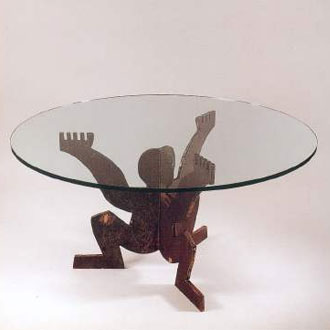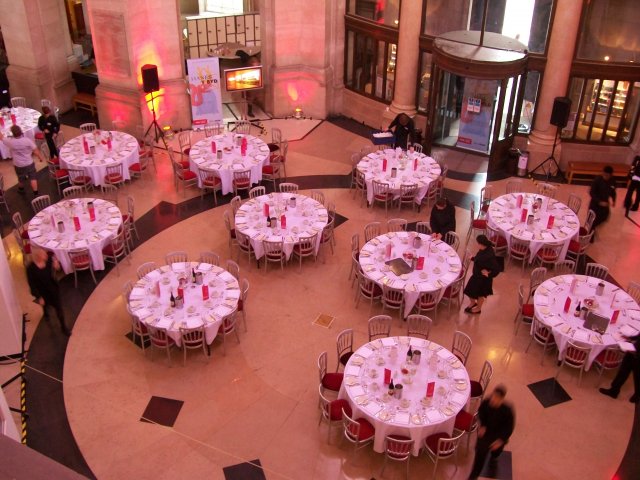George Brecht comes to mind as an artist whose career significantly and famously overlapped his “normal” job working at pharmaceutical companies, as one can hardly imagine two areas that seem less connected. Admittedly this fact is built into a persona, but it is still these days either a fairly rare PR strategy (excepting the tortured furniture designer Cattelan, Nan Goldin the sex trade worker, Serra the mythic steelsmith, Koons the cunning stockbroker) or not very common to talk about one’s money job. Many of the artists we’ve heard of may not have other jobs; a fair amount of them teach, it’s safe to say (or selling the art may be a different job altogether, though it is mostly entrusted to galleries). As a student in Canada, my teachers were all teachers; Nova Scotia doesn’t furnish a bustling art market, so for many living there this was (and is) not an option. When I went to school in Germany this was different; some of the students could even make a pretty decent income from their artwork, or at least position themselves toward this possibility. Not to mention the professors. I don’t dredge all of this up because I want to compare different systems, or the art that comes from them, but because I begin to wonder where a job ends and the art begins, or vice versa. At what point does it become alienation, and in what circumstances does one remove “oneself” from the task at hand, to play a character? (When, in my teacher’s absent gaze, did I see them working on some other idea, their own?)
Artists have it easy, it can be said. Their job is to play (my co-worker, who mostly handles numbers, regularly points this out to me). Certainly the situation is different, the contradictions more grotesque where I live now. When it rains it pours (if by rain I mean that cars, property and nannies fall from the sky), and when it’s dry, one works for someone else… Artists are a hard to characterize lot, the cliché in North America being that they are frequently drawn from the upper-middle classes to be able to pay for the schools, to be able to identify art among their ‘career options’; this image reaches to the threshold of definitions of ‘success’ in characterizing what an artist is, at which point we notice its limitations (a study conducted in Canada shows that artists’ incomes are typically lower than the average: http://theagyuisoutthere.org/wagingculture/). The odd-jobber, the dropout, the hand-to-mouth bohemian are all romantic stereotypes in their own rights, mocking the reality of living off of what you love to do. These two conventional views of artists speak to a term Pierre Bourdieu had described: the ‘heteronomy’ of the field of art – artists’ relative weakness inside a field of relative privilege. To rebuke that the work that art is involved in is not real labour does not merely point out its relative privilege, but cuts art off from the general workforce in an unrealistic and unfruitful way; there is more potential in maintaining this connection.
As someone who has a job but who thinks of themselves as an artist, I am always wondering what is at work while I am working. I am not in a desperate situation financially, and a job like I have (which involves art anyway) is not really for the desperate; in any case, even though I can’t speak for everyone, I believe most people make choices about what they do (while I am by no means advocating a neo-liberal self-made destiny delusion). I have a good job; this isn’t the self-pity of someone who yearns to be free from labour or demands immediately to be discovered. This choice implies a kind of collusion between parts, understandable as a position of mutual benefit, especially in the art field: studio assistants who have access to certain types of visibility or perhaps technical training; part-time writers who can advance their agendas through other channels; gallery staff who cull sources of information or are involved in specific social spheres; these are all easily identified as different routes to attack ‘the same problem’, if our ‘problem’ is success. One can sometimes sense a shuddering of the membrane between generations or hegemonies in these situations, despite the seeming benefits of a job that pays in both financial and symbolic currency. With no slight intended to workers in general, this friction is a special type. The artist, whether seeing time slip away, or through sheer ingratitude, will usually want to change course. This has various reasons –including the widely differing values individuals carry with them, the central importance appointed the individual in art, and the swift and potentially arbitrary transfers of power – however, for now I also don’t want to dwell on this pragmatic level.
I am most curious about what is going on ethically with regard to this supposed split, as to consider labour as experimentation or role play points beyond bald struggles for power and potentially links art and its accompanying work to other forms of labour. This may be called a retreat or a whimsy by some; again, I don’t mean to mock real labour as a form of slapstick; perhaps we don’t yet live in a world where play or self-exploration are tolerated in the general workforce. Speaking from an art perspective, thus it seems all the more worthwhile to reconsider what working means, and to include these considerations in the art that is made. For in art we find an exquisite representation of a baseless economics, and to struggle for power according to someone else’s definition of success (the ruling value system’s, for instance), is to implicitly agree with this representation. Perhaps – and this is probably too rosy-eyed – art that actively engages not only with its status as a commodity (which is better than ignoring it, but is in fact by now quite routine), but that engages with the work required to keep it going, with the choice that lies prior to production and to the production of oneself as an artist, perhaps this can relay with a broader understanding of labour (whose goal is of course control of one’s own means of production); perhaps we can imagine seeing in magnified or frozen state that moment of choice that separates art and work.
There is still this question of the split and how to deal with it, which brings up a host of other questions: Why doesn’t one go all out, become the artist one claims to be, put all the eggs in one basket, the most rewarding? Is it a show of solidarity to know what working is, despite one’s impulses to slough it, an attempt to remain ‘realistic’? Or a reasonably conservative strain of survival instinct? Or a guilty shadow of protestant work ethic? The road signs toward independence and self-determination tell us that we have to use our ‘free time’ to develop ourselves above the labour we produce every day; in fact, this ‘free time’ can be seen as the endangered species of modern work reforms, and in a growing number of industries (especially the creative ones: a word that denotes increasingly and manifold other industries) is replaced by a flexible work schedule one never clocks out of. Perhaps, considering this tendency, it is worth crossing the free time/work time line with an inverse motion, kidnapping work for art.
To think of a job as an experiment necessitates a suspension from the very personal panic derived from our desires not being fulfilled. It may necessitate the adoption of multiple personalities, and it may cause confusion and doubt about one’s purpose, as it sets up a double-life in which one half pulls most of the weight of our ambitions. I think as a form of research it can always be recuperated or transferred into an art piece later; I am not talking about asceticism or denial of the worldly. It is more about pausing for a moment on the crossroads where the artist in us escapes down an alley and the worker marches on. If I were to call on artists to pursue this masquerade, I would also call on bosses everywhere to do the same.
Maybe Santiago Sierra could try a job at Starbucks?
(originally posted on the Vitamin Creative Space blog, 09/05/2009)

